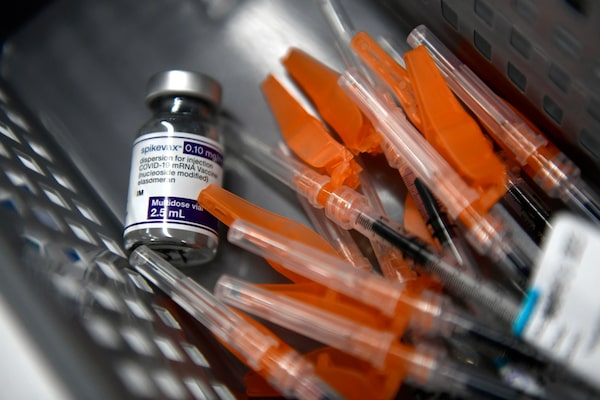
More than any other stock, Moderna was a pure play on COVID-19 vaccines.Justin Tang/The Canadian Press
One glance at Moderna Inc.’s MRNA-Q stock chart can tell you the story of the COVID-19 pandemic.
It’s all there, starting with the rumblings in the pharma company’s share price in early 2020 as a mysterious flu in Wuhan, China, began to set off red flags. Then the quick emergence of a boom in pharma stocks, as COVID-19 put four billion people into lockdown. That morphed into an outright gold rush after highly effective vaccines became a surprise reality in late 2020. Finally, there was a long selloff as the crisis was subsumed into daily life.
The rise and fall of Moderna’s share price is not just a remarkable distillation of how a global disaster played out in the stock market. It should also serve as a reminder that investing themes are perishable, even if it feels in the moment like this time is truly different.
Moderna’s stock has now declined by 85 per cent from its peak. On Wednesday, it closed at US$76.35 – almost exactly where it was trading three years ago. That was just before the first clinical trial data signalled to the world that vaccines were coming and had the potential to bring an end to the pandemic.
There were many stocks big and small that got lumped in with the worldwide campaign to control the virus. But more than any other, Moderna was a pure play on COVID-19 vaccines.
When the pandemic hit, Moderna was a 10-year-old development stage company with no approved drugs and a market capitalization of less than US$10-billion.
Its vaccine immediately thrust Moderna into the ranks of Big Pharma. Within 18 months, the company was valued at close to US$200-billion. Its shares rose by nearly 2,500 per cent up to their peak. Put another way, if you invested US$400 in Moderna shares at the start of the pandemic, it would have turned into US$10,000 by mid-2021.
An entire ecosystem of health care and biotech companies flush with government cash and investor enthusiasm rode the market’s hottest trade skyward. For many investors in a pandemic mindset, it was probably easy to imagine these fortunes extending indefinitely.
But then, of course, the grip of the pandemic loosened, and the World Health Organization eventually declared an end to the global health emergency.
Do I really need to get another COVID shot this fall?
New evidence confirms COVID-19 vaccines are overwhelmingly safe
By mid-2021, the turning point was in, and the pandemic trade has been receding ever since. The minds of health care investors have instead shifted to weight-loss drugs, with the likes of Novo Nordisk A/S and Eli Lilly and Co. LLY-N assuming leadership of the sector.
Demand for COVID-19 vaccines, meanwhile, has plunged. A couple of months ago, Pfizer PFE-N said it expects a COVID-19 vaccination rate of about 24 per cent this year in the U.S., which is about half the typical rate for seasonal influenza. On Tuesday, the company announced it was cutting 500 jobs in Britain as part of a US$3.5-billion cost-cutting effort.
Moderna’s latest guidance pegs the company’s vaccine revenues for this year at around US$6-billion, down from US$19-billion in 2022. In fact, the company is expected to lose money for at least the next couple of years before returning to profitability in 2026 at the earliest.
It would be a mistake, however, to assume that Moderna squandered its windfall. Those pandemic riches were largely plowed into the development of other medications, from a combination flu and COVID-19 shot to personalized cancer vaccines.
“The pandemic enabled the company to build a stockpile and fund R&D well into the future,” said Eden Rahim, a health-care focused portfolio manager at Next Edge Capital.
After role playing among the established elite of the global drug industry, Moderna has essentially reverted to a development stage biotech firm. And when you look at the company’s current US$29-billion valuation through that lens, the stock is still not cheap, even after an 85-per-cent selloff, Mr. Rahim said.
It may be hard for Moderna shareholders to accept that the company has come full circle to its pre-COVID vaccine share price. But this is how it often goes for stocks that are driven to stratospheric heights by investor euphoria.
Mr. Rahim cites the classic example of the Radio Corporation of America, once a leading radio manufacturer. Its stock peaked in 1929 and didn’t hit a new high until 1983, despite all the profits that accrued from radio innovation in the intervening decades.
“Once an epic parabola reverses, the trade is usually over for a decade or more,” Mr. Rahim said.